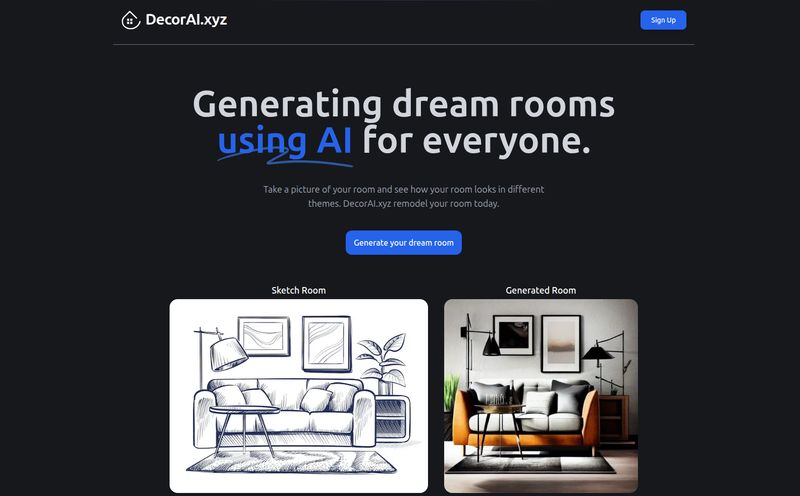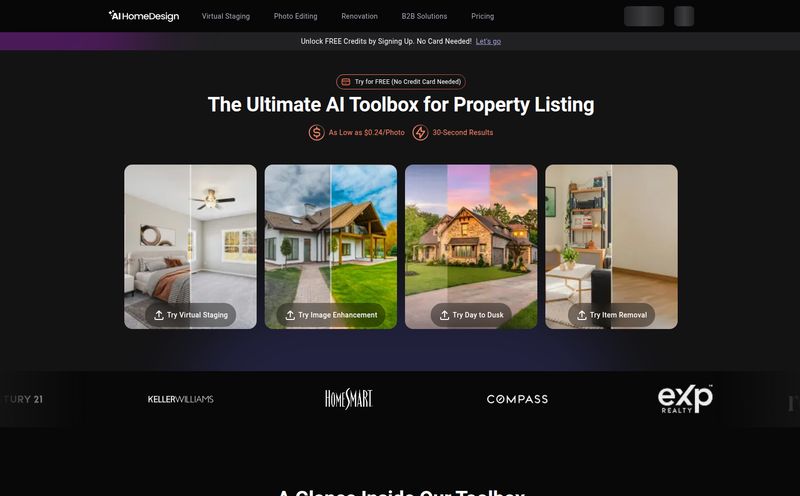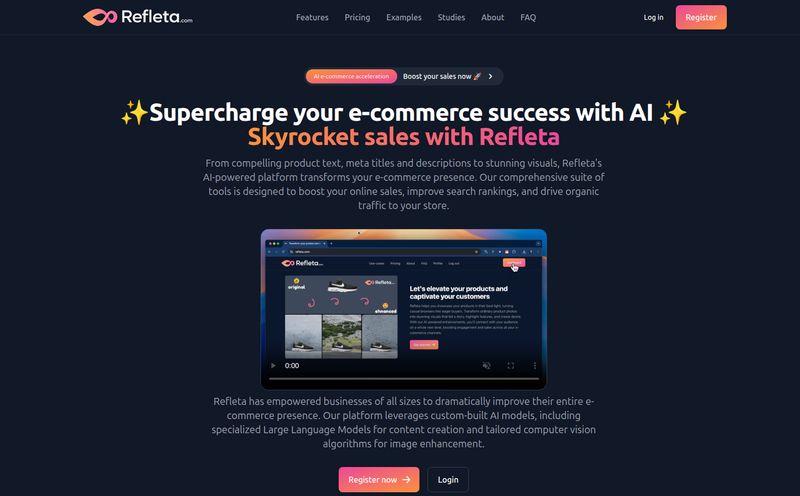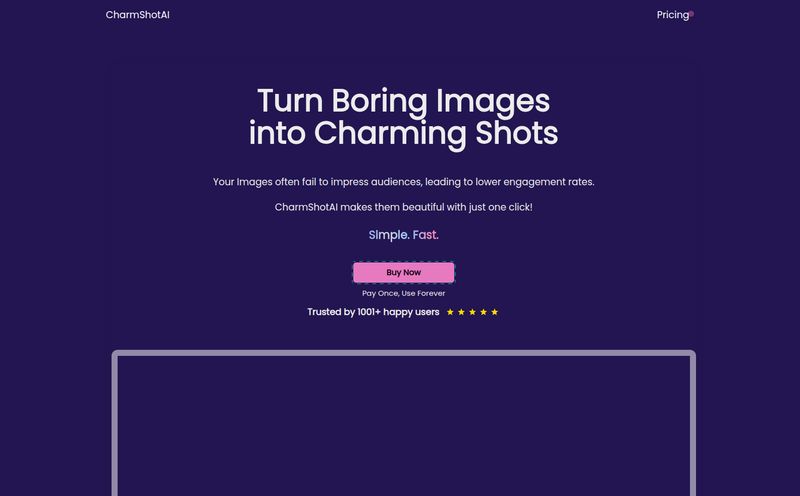We’ve all been there. You find the perfect image for your new blog post. It’s got the right vibe, the right subject, everything. But there’s one tiny, soul-crushing problem. It's the size of a postage stamp. You try to resize it, and suddenly it looks like a pixelated mess from a 1990s video game. It's a tale as old as the internet itself, and one that has sent many a content creator into a spiral of despair.
For years, the mantra was simple: you can’t create data from nothing. If the pixels aren't there, they aren't there. End of story. But then, AI sauntered onto the scene, looked at our blurry, low-res photos, and said, “Hold my beer.”
I’ve been knee-deep in AI tools for a while now, from text generators to video creators. Some are revolutionary. Others are… well, let's just say they have room to grow. So when I stumbled upon jpgHi, an AI tool promising “lossless upscaling” and “extreme detail restoration,” my professional skepticism kicked in. But, I'll admit, so did a little flicker of hope. Could this finally be the simple, effective solution to our collective low-res woes?
Spoiler alert: It’s pretty darn close.
What Exactly is jpgHi and Why Should You Care?
At its heart, jpgHi is an AI-powered image upscaler. But that description feels a bit like calling a Ferrari a “car.” It doesn't quite capture the nuance of what’s happening under the hood. Instead of just stretching an image and trying to smooth out the jagged edges (the old, clumsy way), jpgHi uses sophisticated AI models. It’s been trained on countless images to understand what things are supposed to look like.
Think of it less like a photocopier and more like a forensic artist. It looks at a blurry face and doesn't just enlarge the blur; it reconstructs what the pores, the individual strands of hair, and the freckles should look like. It sees a fuzzy bird and rebuilds the delicate texture of its feathers. This process allows it to upscale images by up to 16 times their original size while adding detail that simply wasn't visible before. For anyone in the content game, from bloggers to e-commerce store owners, the implications are massive.
A First Look at the User Experience
My first impression of the platform? Refreshingly simple. In a world where every new tool seems to require a 10-part video tutorial, jpgHi greets you with a clean interface and a single, glorious button: “Select Image.” That’s it. No complicated dashboards, no labyrinth of menus. You upload your image, pick your settings, and let the AI do its thing.
This simplicity is a huge win. I don't have time to become an expert in yet another piece of software. I need tools that work with me, not against me, and jpgHi gets that. It’s a browser-based tool, so there's nothing to download or install. It just works.
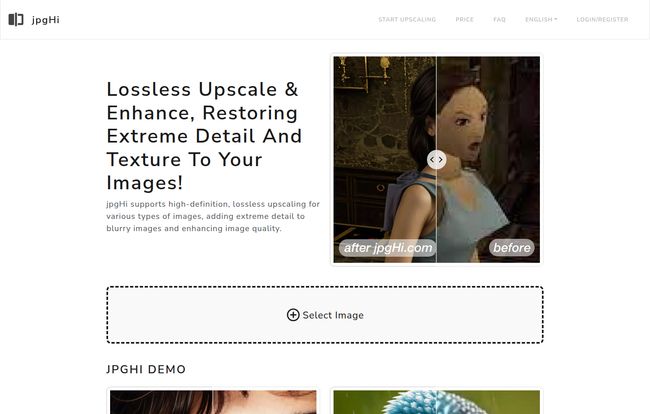
Visit jpgHi
The Magic in Action: Those Before and After Results
Okay, let's get to the good stuff. The proof is in the pudding, or in this case, the pixels. The demos on the jpgHi site are, frankly, startlingly good. They showcase a wide range of subjects, which is a great sign of a well-trained AI.
- The Portrait: A woman's face goes from a soft, blurry image to one where you can see individual freckles and the texture of her skin. It's not just sharper; it feels more real.
- The Kingfisher: This one got me. The original bird is a smudge of blue and orange. After jpgHi, you can see the individual barbs of its feathers and the glint of water droplets. Wow.
- The Anime Girl: Even illustrative styles get a boost. A pixelated anime character is restored to clean lines and smooth gradients, completely removing the compression artifacts. This shows it's not just for photorealism.
It’s this versatility that sets it apart. It seems to have a different approach for different subjects, whether it’s the hard lines of architecture or the soft organic details of nature.
The Nitty-Gritty Details of jpgHi
So, how does it pull this off? Let's look at some of the core features that make jpgHi tick.
True Lossless Upscaling up to 16x
The term “lossless” is key here. Normally, when you enlarge a JPG, you lose quality with every pixel you add. The image gets bigger, but it also gets worse. jpgHi’s method is generative. It’s creating new, sharp details to fill the new space, resulting in a larger file that is also significantly higher in quality. Being able to go up to 16x is impressive and more than enough for most web and even some print applications.
Intelligent Detail and Texture Restoration
This is the AI's secret sauce. The system doesn't just apply a one-size-fits-all sharpening filter. It identifies elements within the photo and enhances them appropriately. It adds fine lines to hair, texture to stone, and clarity to fabric. It’s a much more intelligent process that avoids that crunchy, over-sharpened look that plagues older enhancement techniques.
A Privacy First Approach
In an era where we're all a bit (and rightfully so) paranoid about our data, this is a huge plus. According to their FAQ, jpgHi automatically deletes your uploaded and processed images after a period of time. They aren’t using your personal photos to train their models without permission. For businesses handling client images or anyone concerned with privacy, this is a major green flag.
Let's Talk Money and the jpgHi Pricing Model
Alright, so what’s this going to cost? jpgHi runs on a token-based system, which is pretty common for AI services that use a lot of processing power. The good news is, you can dip your toes in the water without spending a dime.
Here’s a quick breakdown of their plans:
| Plan | Tokens | Price (JPY) | Key Features |
|---|---|---|---|
| Free | 5 per month | ¥0 | Slow processing, watermarked images |
| Monthly | 180 | ¥36 | Valid for 1 month, priority processing |
| Semi-Annual | 500 | ¥90 (on sale from ¥120) | Valid for 6 months, priority processing |
| Annual | 1200 | ¥180 (on sale from ¥300) | Valid for 12 months, priority processing, early access to new features |
The first thing you’ll notice is the currency is Japanese Yen (¥). Now, don't let that scare you. When you do the conversion, these prices are incredibly affordable. We’re talking cents, not dozens of dollars. The value here seems almost too good to be true, making it highly accessible for freelancers, small bloggers, or anyone on a tight budget. The free plan is perfect for testing, though the watermark and slow speed will probably push any serious user towards a paid plan. The token system means you only pay for what you actualy use.
The Not-So-Perfect Side of jpgHi
No tool is perfect, and a fair review needs to point out the potential downsides. While I'm largely impressed, there are a few things to keep in mind.
First, the 'garbage in, garbage out' principle still applies, albeit to a lesser degree. If your source image is an unrecognizably blurry block, the AI can only do so much. It needs some data to work with. For best results, start with the highest quality version of the image you have, even if it’s small.
Second, the token system, while fair, can be a bit of a pain if you have a massive batch of images to process. You need to keep an eye on your balance. Also, be aware that there are no refunds once a process has started, which is standard for this kind of service but good to know upfront.
How jpgHi Can Boost Your SEO Strategy
As an SEO guy, my mind immediately goes to the ranking implications. And there are plenty. Google has been vocal about the importance of user experience for years. And what's a bigger user experience killer than a page full of ugly, pixelated images?
High-quality images can:
I see a huge opportunity here for refreshing old content. Go back to your most popular blog posts from five years ago. I guarantee some of the images are looking a bit tired and low-res by today's standards. Instead of trying to hunt down new ones, you could run them through jpgHi and give that old content an instant, high-impact facelift. It's a low-effort, high-reward tactic for improving your existing assets. As Google's own Image SEO best practices guide suggests, high-quality photos are preferred in search results.
Frequently Asked Questions about jpgHi
I've rounded up some common questions you might have, based on their site and my own experience.
What is the principle behind jpgHi.com?
It uses advanced AI models, likely a form of Generative Adversarial Network (GAN), that have been trained to recognize patterns and textures in images. It then intelligently generates new pixels to enlarge the image while enhancing these details, rather than just stretching it.
How do you get the best results?
Start with the best possible source image you have. A clear but small image will yield much better results than a large but extremely blurry or compressed one. Garbage in, better-looking-garbage out is the best you can hope for with a truly terrible original.
Why is there a fee for a service like this?
The AI processing, especially for high-resolution upscaling, requires a massive amount of computational power. This is done on powerful cloud GPU servers, which are expensive to run and maintain. The fees cover these operational costs.
What is the platform's policy on privacy?
jpgHi states that they value user privacy and automatically delete user-uploaded images from their servers after processing is complete. This means your images aren't stored indefinitely or used for other purposes.
Can I get a refund if I'm not happy?
Once an image has started processing and tokens have been used, refunds are generally not available. This is because the computational cost has already been incurred. It's best to use the free tokens to test the service with your own images first.
Are tokens refunded for failed tasks?
Yes. Based on their FAQ, if an upscaling task fails for a technical reason (like an upload error), the tokens used for that task will be refunded to your account.
My Final Verdict: Is jpgHi the Real Deal?
So, after kicking the tires and running some images through it, what's my final take? Yes, jpgHi is the real deal.
It’s a powerful, accessible, and surprisingly affordable tool that solves a very real, very common problem for anyone who works with digital media. It's not a magic wand that can turn a single pixel into a 4K masterpiece, but its ability to revive and enhance low-resolution images is genuinely impressive.
This tool is perfect for bloggers, social media managers, e-commerce site owners, and even amateur photographers who want to rescue old digital photos. The simplicity of its interface combined with the complexity of its results is a winning combination. If you’ve ever looked at a blurry image with a heavy heart, I’d say it’s absolutly worth giving jpgHi’s free version a spin. You might be surprised at the magic it can work.
